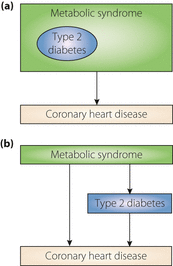Metabolic syndrome as a predictor of type 2 diabetes, and its clinical interpretations and usefulness
- PMID: 24843675
- PMCID: PMC4020225
- DOI: 10.1111/jdi.12075
Metabolic syndrome as a predictor of type 2 diabetes, and its clinical interpretations and usefulness
Abstract
Metabolic syndrome is defined as a cluster of glucose intolerance, hypertension, dyslipidemia and central obesity with insulin resistance as the source of pathogenesis. Although several different combinations of criteria have been used to define metabolic syndrome, a recently published consensus recommends the use of ethnic-specific criteria, including waist circumference as an indicator of central obesity, triglyceride and high-density lipoprotein (HDL) cholesterol as indicators of dyslipidemia, and blood pressure greater than 130/85 mmHg. The definition of dysglycemia, and whether central obesity and insulin resistance are essential components remain controversial. Regardless of the definition, the prevalence of metabolic syndrome is increasing in Western and Asian countries, particularly in developing areas undergoing rapid socioenvironmental changes. Numerous clinical trials have shown that metabolic syndrome is an important risk factor for cardiovascular disease (CVD), type 2 diabetes mellitus and all-cause mortality. Therefore, metabolic syndrome might be useful as a practical tool to predict these two major metabolic disorders. Comprehensive management of risk factors is very important to the improvement of personal and public health. However, recent studies have focused on the role metabolic syndrome plays as a risk factor for CVD; its importance in the prediction of incident diabetes is frequently overlooked. In the present review, we summarize the known evidence supporting metabolic syndrome as a predictor for type 2 diabetes mellitus and CVD. Additionally, we suggest how metabolic syndrome might be useful in clinical practice, especially for the prediction of diabetes.
Keywords: Metabolic syndrome; Risk factor; Type 2 diabetes mellitus.
Figures
References
-
- Alberti KG, Zimmet PZ. Definition, diagnosis and classification of diabetes mellitus and its complications. Part 1: diagnosis and classification of diabetes mellitus provisional report of a WHO consultation. Diabet Med 1998; 15: 539–553 - PubMed
-
- Balkau B, Charles MA. Comment on the provisional report from the WHO consultation. European Group for the Study of Insulin Resistance (EGIR). Diabet Med 1999; 16: 442–443 - PubMed
-
- Expert Panel on Detection, Evaluation, and Treatment of High Blood Cholesterol in Adults . Executive Summary of The Third Report of The National Cholesterol Education Program (NCEP) Expert Panel on Detection, Evaluation, And Treatment of High Blood Cholesterol In Adults (Adult Treatment Panel III). JAMA 2001; 285: 2486–2497 - PubMed
-
- Reaven GM. Banting lecture 1988. Role of insulin resistance in human disease. Diabetes 1988; 37: 1595–1607 - PubMed
-
- Fontbonne A, Charles MA, Thibult N, et al Hyperinsulinaemia as a predictor of coronary heart disease mortality in a healthy population: the Paris Prospective Study, 15‐year follow‐up. Diabetologia 1991; 34: 356–361 - PubMed
Publication types
LinkOut - more resources
Full Text Sources
Other Literature Sources


